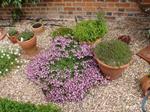 Creating new plants from old is not only fascinating and
simple, it’s also the most economical means of adding to your garden.
Creating new plants from old is not only fascinating and
simple, it’s also the most economical means of adding to your garden.
Propagating your own herbs can be one of the most
addictive and rewarding of gardening pursuits. It’s really quite easy once you
know how.
The annual herbs are normally propagated by seeds.
Biennial and perennial herbs can also be propagated by seed, though other
techniques such as division or cuttings are frequently used. Some herbs
(including tarragon and certain mints) rarely produce seeds, making propagation
by division or cuttings the only alternative. Selected varieties of herbs grown
for both commercial cropping or home garden use, are often propagated by
division or cutting, ensuring the new plants have the same characteristics as
the parent. Some perennials (e.g. Fraxinella) are best propagated by division
or cuttings because of slow seed germination.
A reliable source of seeds is essential when propagating.
Dealers usually handle the varieties which are in high demand but it is often
difficult to obtain seed for the less common varieties or when you do, there is
no guarantee you’ve got the herb you wanted. You can usually depend on the
varieties of parsley and chives you buy but the mints, thymes and sages can
sometimes be different from what their labels indicate. The best advice is to
double check the credibility of suppliers and still be suspicious of the
accuracy of the naming of seeds until you have grown and checked the plant
yourself.
PROPAGATION BY DIVISION
Some herbs such as chives, creeping thymes and mints form
clumps or mats which can be divided to form new plants. Divide by placing two
forks into the clump and separating. Rock the forks back and forth as you pull
to loosen the soil and tangled roots. Try to avoid tearing which might damage
roots. Some nurserymen cut clumps with a spade or knife but this exposes cut
tissue to infection and while this is less desirable than the other method,
most hardy herbs will resist infection through cuts.
Stock plants are best grown in a sandy or loose soil in
containers such as buckets or 3.5 gallon tubs. The divisions will separate
easier than in a clay soil. Other herbs which grow readily from division
include: Salad Burnet, Germander, Horehound, Orris Root, Lemon Balm, Pot
Marjoram, Sorrel, Tansy, Violets, Sweet Woodruff and Yarrow.
PROPAGATION BY CUTTINGS
Woody herbs such as Sage, Lavender, Rosemary, Santolina,
Lemon Verbena and Bay, are commonly grown from cuttings. Cuttings are normally
5-7 cm semi-hardwood (taken late January to April) with rooting hormone.
Cuttings are inserted into either growool propagating blocks, or in a 75 %
sand/25 % peat mix (in plastic pots or trays) and placed in a greenhouse, cold
frame or better still, a heated propagating bed. These plants can take anything
from one to seven months to form roots. When roots form they can be potted up
into tubes or larger pots.
PROPAGATION BY LAYERS
Layering involves pinning a branch or stem down to the
ground (perhaps with a small wire peg) and covering a section with soil. Over a
period of time, roots will develop on the section of stem below the soil. Once
a reasonable root system had developed, the layered section can be cut off the
original plant and potted up into a container.
Herbs which grow easily from layers include: Lemon Balm,
Marjoram, Mint, Savory, Tarragon, Thyme, Santolina and the Sages.
PROPAGATION BY SEEDS
Seeds are normally sown in spring after the frosts have
finished. May herbs can be sown direct into the soil outdoors. A few of the
more difficult types may be better sown in a glasshouse or cold frame (i.e. as
outside box with a glass or plastic lid). Most seed-grown herbs can be started
earlier by sowing outdoors.
Provided the temperature is adequate (18 to 25 °C for most), seeds will germinate
and young seedlings will grow at any time of the year.
The seeds of Flaxinella, Sweet Cicely and Lovage should be
sown in late summer as soon as they are ripe.
In an established herb garden, many varieties will self
seed, so much that they can even become weeds.
The following varieties are notorious for slow seed
germination: Good King Henry, Lavender, Lemon Balm, Wormwood, Rosemary, Sweet
Woodruff. Parsley seeds are known to be slow germinating but our experience
would disagree, provided the seeds are fresh.